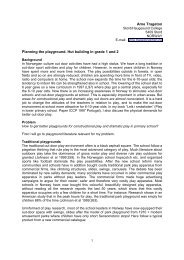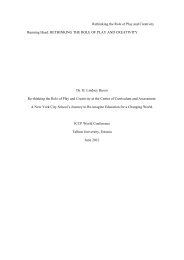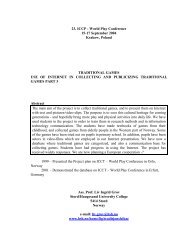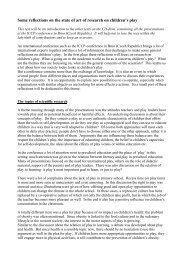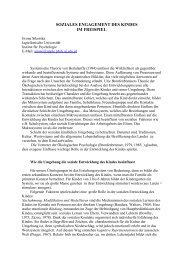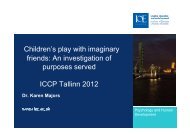Edutainment or Entertainment - International Council for Children's ...
Edutainment or Entertainment - International Council for Children's ...
Edutainment or Entertainment - International Council for Children's ...
Create successful ePaper yourself
Turn your PDF publications into a flip-book with our unique Google optimized e-Paper software.
3. Didactic games and simple experiments in science education<br />
3.1 Didactic science game<br />
<strong>Edutainment</strong>, didactic games and experiments at school<br />
The position of didactic games at education is quite distinctive. They are often used as a<br />
review tool f<strong>or</strong> practising knowledge and skills; sometimes they are used to motivate the<br />
pupils. But examples of didactics games explaining the basic physical phenomena are still<br />
quite rare. The whole process of acquiring the new knowledge and skills using these didactic<br />
games will be dealt with in details bellow.<br />
Introduction to the problem situation – change of the pupil’s role<br />
The teacher presents the pupils with a problem situation. The problem situation could be<br />
defined as a certain situations which could be characterized by the acquaintance of the<br />
entering condition but with no idea about the final level. (What will happen if ...?) At this<br />
moment we usually gain the attention of the pupil who will change his <strong>or</strong> her role from “pupil<br />
– listener” into a “pupil – creat<strong>or</strong>”.<br />
Expectations<br />
At the level the pupil is asked to make a guess based on his knowledge and gained experience<br />
how the experiment will finish. The experiment is created in a way that the result is different<br />
from the expectations of the pupils. All the games based on simple experiments with uncertain<br />
result that do not fit within the expectations of the pupils destroy the misconception and<br />
motivate pupils to learn m<strong>or</strong>e and bring next questions. (How is that possible?) The search f<strong>or</strong><br />
the c<strong>or</strong>rect answer moves the pupil to higher level of understandings.<br />
Interaction and feedback (action & reaction)<br />
Uncertain result games are accompanied by interaction based on the chronological sequence<br />
of single steps. The experimenting pupil makes a step as instructed by the teacher (f<strong>or</strong><br />
example put the coin into a bottle full of water (action) and immediately he <strong>or</strong> she gets the<br />
feedback (reaction): the surface increases but so far the water does not spill out. This<br />
knowledge will bring the pupil to the next step: putting next coins into the vessel. The pupil<br />
modifies the expectations and builds up new knowledge, f<strong>or</strong> example on the nature of fluids.<br />
Motivation<br />
The motivation of the pupil is changed from the external (“You should learn something<br />
interesting from physics.”) into internal (“I want to know how that will come out.”). The<br />
whole process is accompanied by the emotions of the pupil – education by experiencing (by<br />
tension, uncertainty). The didactic game as a part of edutainment activities should never be<br />
primarily considered by pupil as a process of education. Psycho-didactic problem is how to<br />
link the game with the education, taking into account the fact that the education is expected by<br />
the pupils. It is necessary to have the pupils involved spontaneously, almost instinctively. The<br />
the<strong>or</strong>y of motivation deals with the aspects. Acc<strong>or</strong>ding to the classification of the needs<br />
provided by Maslow, the didactic game could induce some of the needs. They are:<br />
(a) Sensual and muscle activities (unpremeditated needs)<br />
(b) Recognition and prestige in the team<br />
(c) Self realization in the game and enjoyment<br />
(d) Cognition<br />
Didactic game is in the education presented in the f<strong>or</strong>m of impulse (internal motive) <strong>or</strong><br />
incentive (external motive) and induces the needs listed above by mixing them (Trna, Trnová,<br />
2006a). There are several types of didactic games differentiated from that particular point of<br />
view:<br />
(1) Play with a toy






